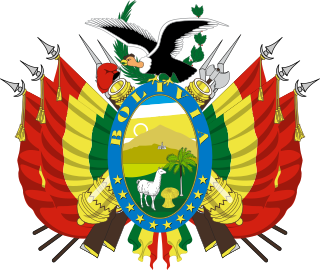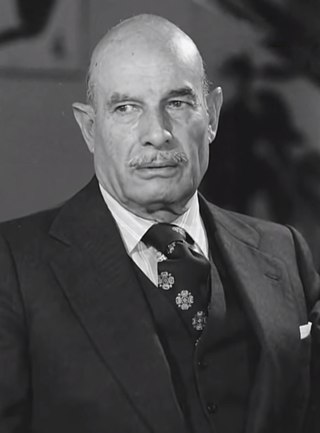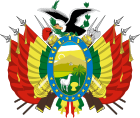
The Movement for the Liberation of São Tomé and Príncipe – Social Democratic Party is one of the main political parties in São Tomé and Príncipe. Jorge Bom Jesus is the current president of the party.

Hernán Siles Zuazo was a Bolivian politician who served as the 46th president of Bolivia twice nonconsecutively from 1956 to 1960 and from 1982 to 1985. He also briefly served as interim president in April 1952, and as the 27th vice president of Bolivia from 1952 to 1956.

Bolivia elects on national level a head of state – the president – and a legislature. The president and the vice-president are elected for a five-year term by the people. The National Congress has two chambers. The Chamber of Deputies has 130 members, elected for a five-year term using a two vote seat linkage compensatory system and in the case of seven indigenous seats by usos y costumbres. The Chamber of Senators has 36 members: each of the country's nine departments returns four senators allocated proportionally.

The Christian Democratic Party is an ultraconservative political party in Bolivia.

General elections were held in Bolivia on 18 December 2005. Evo Morales of the Movement for Socialism (MAS) party was elected President of Bolivia with 54% of the vote, the first time a candidate had received an absolute majority since the flawed 1978 elections. Morales was sworn in on 22 January 2006 for a five-year term. The MAS also won a majority of seats in the Chamber of Deputies and emerged as the largest party in the Senate.

José Enrique Hertzog Garaizábal was a Bolivian physician and politician who served as the 42nd president of Bolivia from 1947 to 1949.

Wálter Guevara Arze was a Bolivian statesman, cabinet minister, writer, and diplomat, who served as the 54th president of Bolivia on an interim basis in 1979.

General elections were held in Bolivia on 1 June 1997. As no candidate for the presidency received over 50% of the vote, the National Congress was required to elect a president on 4 August. Hugo Banzer of Nationalist Democratic Action (ADN) was subsequently elected. Whilst the ADN emerged as the largest party in Congress, it failed to win a majority of seats, and formed a coalition government with the Revolutionary Left Movement, Conscience of Fatherland and the Solidarity Civic Unity.
The Liberal Party was a liberal political party in Bolivia active between 1883 and 1979. It was one of two major parties, alongside the Conservative Party, that dominated the politics of Bolivia from 1884 to 1920. The Liberals constituted the primary opposition to the Conservatives from 1884 to 1899 and ruled continuously from 1899 to 1920 after taking power in the Federal War. Liberal rule ended in 1920 when the party was ousted in a coup d'état. The Liberals remained intermittently influential and electorally competitive until the Bolivian National Revolution of 1952, and it finally lost its legal party status in 1979, during the democratic transition.

General elections were held in Bolivia on 7 May 1989. As no candidate for the presidency received over 50% of the vote, the National Congress was required to elect a president on 6 August. Although the Revolutionary Nationalist Movement had received the most votes, its candidate for President Gonzalo Sánchez de Lozada was defeated by Jaime Paz Zamora of the Revolutionary Left Movement (MIR) in the congressional vote, despite the MIR only finishing third in the public vote.

General elections were held in Bolivia on 6 June 1993. As no candidate for the presidency received over 50% of the vote, the National Congress was required to elect a president on 4 August. Gonzalo Sánchez de Lozada of the MNR-MRTKL alliance was subsequently elected unopposed.

General elections were held in Bolivia on 9 July 1978. The elections were the first held since 1966, with several military coups taking place during the late 1960s and early 1970s. Although Juan Pereda of the Nationalist Union of the People won the presidential elections according to official statements, more votes were cast than there were registered voters. After examining a number of allegations of fraud and other irregularities, the National Electoral Court decided to annul the results on 19 July. The following day, Pereda was installed as President following a military coup. Pereda himself was overthrown by yet another military coup in November, which saw General David Padilla assume the presidency. Fresh elections were held the following year, with Padilla transferring power to his democratically elected successor, Wálter Guevara.

General elections were held in Bolivia on 1 July 1979. As no candidate in the presidential elections received a majority of the vote, the National Congress was required to elect a President. However, the Congress failed to elect a candidate after three ballots and instead selected Senate leader Wálter Guevara to serve as Interim President for a year on 8 August. Guevara was later overthrown by a military coup led by Alberto Natusch on 31 October. Fresh elections were held in June 1980.

General elections were held in Bolivia on 29 June 1980, the third in three years. As no candidate in the presidential elections received a majority of the vote, the National Congress was required to elect a President on 6 August. With Hernán Siles Zuazo of the Democratic and Popular Union the favourite to win the Congressional ballot, the process was disrupted on 17 July by the military coup led by General Luis García Meza Tejada. However, Meza was pressured to resign on 4 August 1981, resulting in General Celso Torrelio becoming president. In July 1982 he was replaced by General Guido Vildoso, who was named by the high command to return the country to democratic rule. On 17 September 1982, during a general strike that brought the country close to civil war, the military decided to step down, to reconvene the National Congress elected in 1980, and to accept its choice of president. Accordingly, the National Congress revalidated the 1980 election results on 23 September and overwhelmingly elected Hernán Siles Zuazo as president on 5 October. He subsequently assumed the presidency on 10 October 1982.

General elections were held in Bolivia on 14 July 1985. As no candidate for the presidency received over 50% of the vote, the National Congress was required to elect a President on 4 August. Although Hugo Banzer of Nationalist Democratic Action (ADN) received the most public votes, Congress elected Víctor Paz Estenssoro of the Revolutionary Nationalist Movement (MNR).

The Republican Socialist Unity Party was a political party founded on 10 November 1946 in Bolivia as the fusion of the Republican Socialist Party, the Genuine Republican Party, the United Socialist Party, and the Independent Socialist Party.
The Social Democratic Party was a conservative, small and elitist, but influential Bolivian political party formed by middle-class intellectuals.

Enrique Hertzog assumed office as the 42nd president of Bolivia on 10 March 1947, and his term ended upon his resignation on 22 October 1949. A physician who served in various ministerial positions since the 1920s, Hertzog was elected as the head of the Republican Socialist Unity Party (PURS) ticket in the 1947 general elections.

Gabriel Gosálvez Tejada was a Bolivian politician, journalist, economist, and diplomat. Throughout his political career, Gosálvez held various ministerial officers and diplomatic posts as a member of the United Socialist Party. When that party merged into the Republican Socialist Unity Party, Gosálvez was presented as its presidential candidate in the 1951 general election.



















